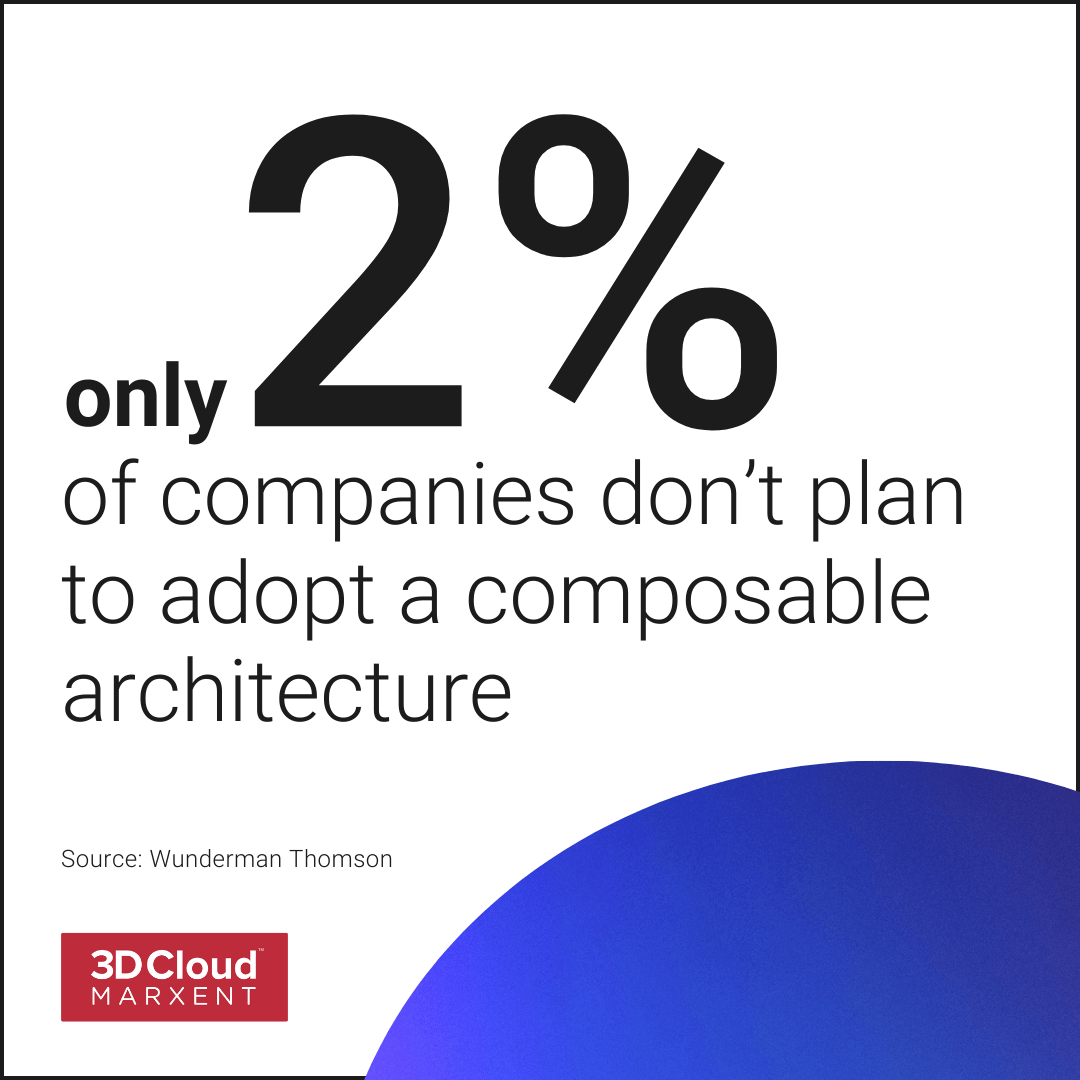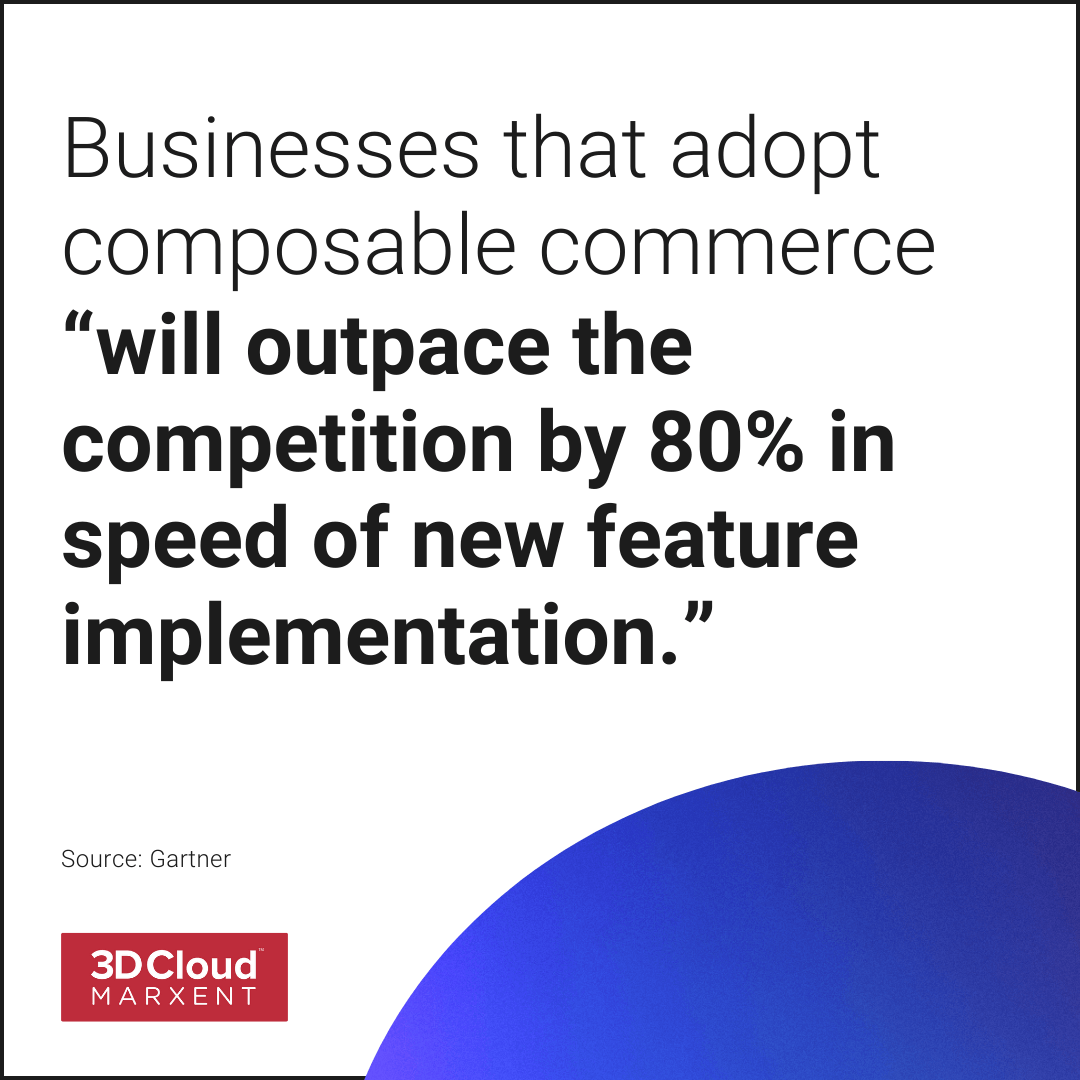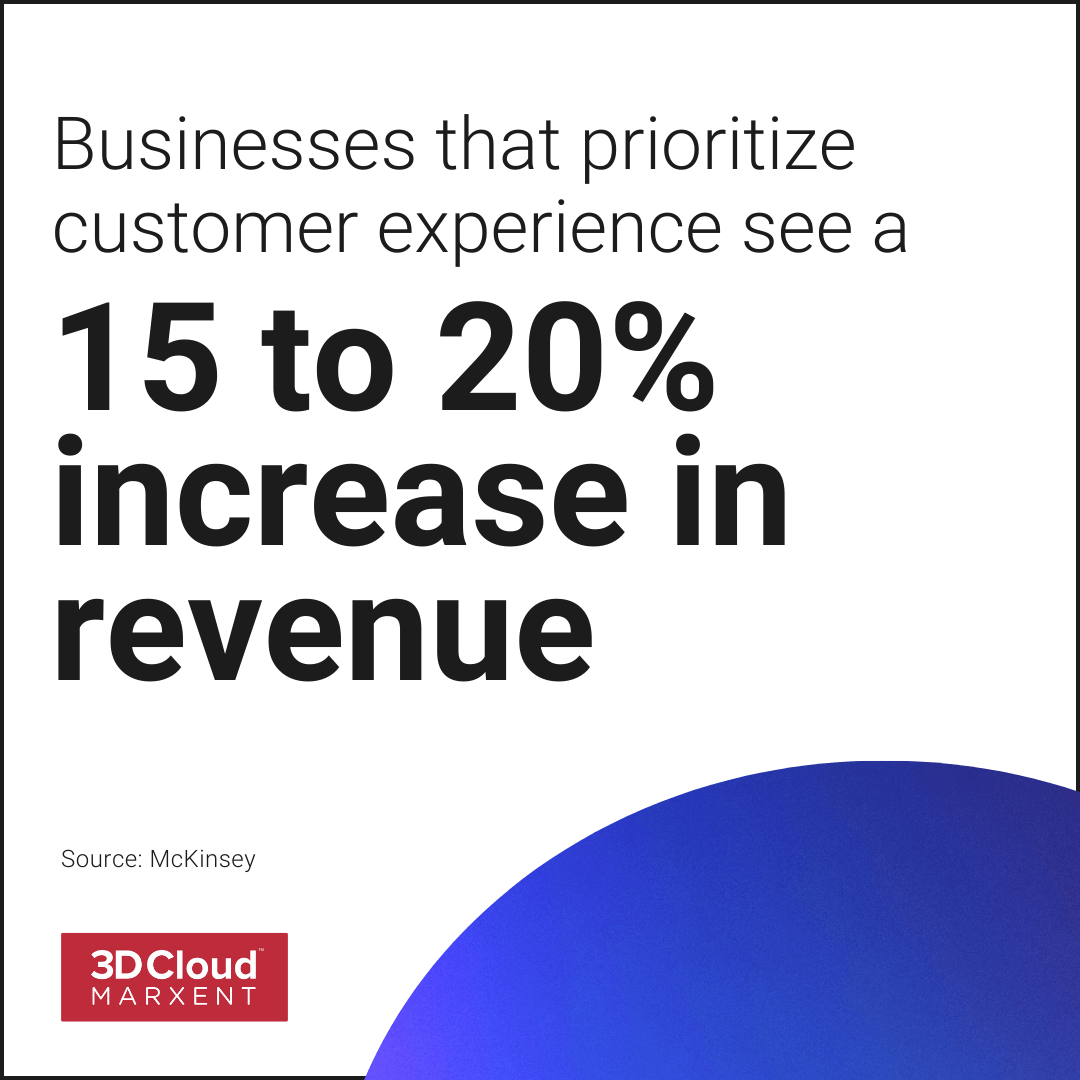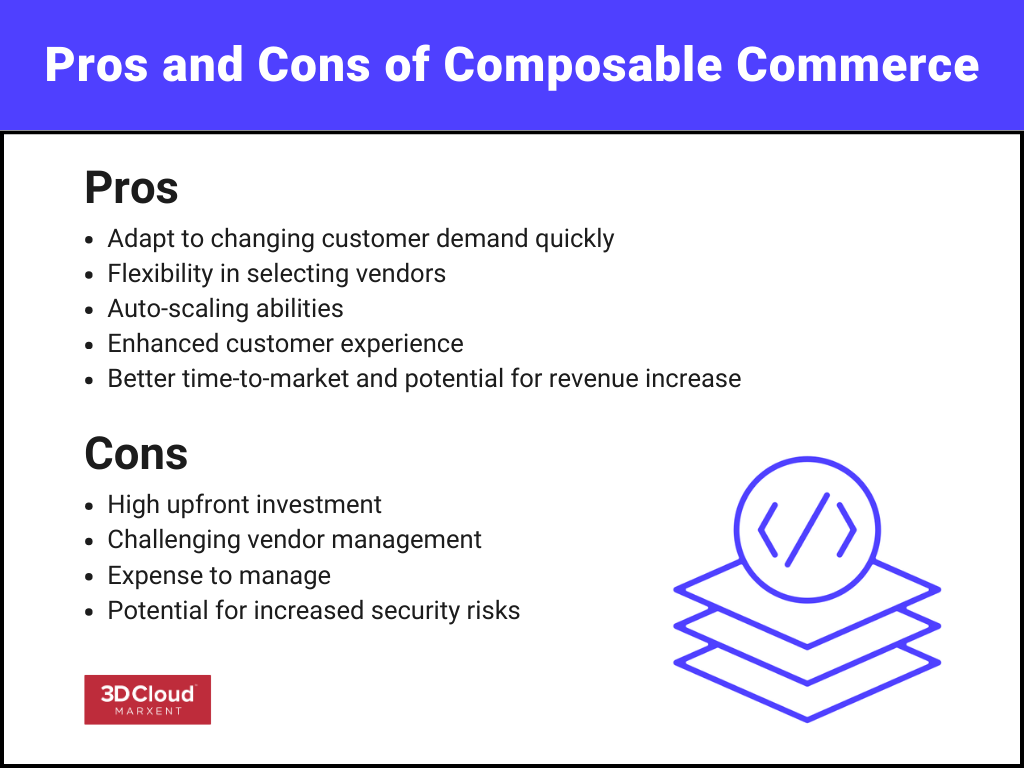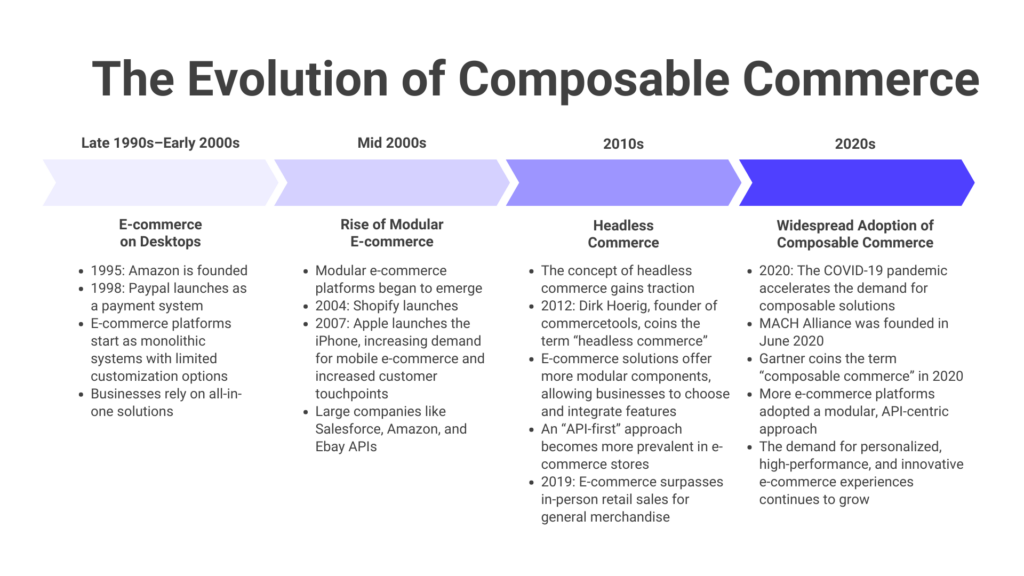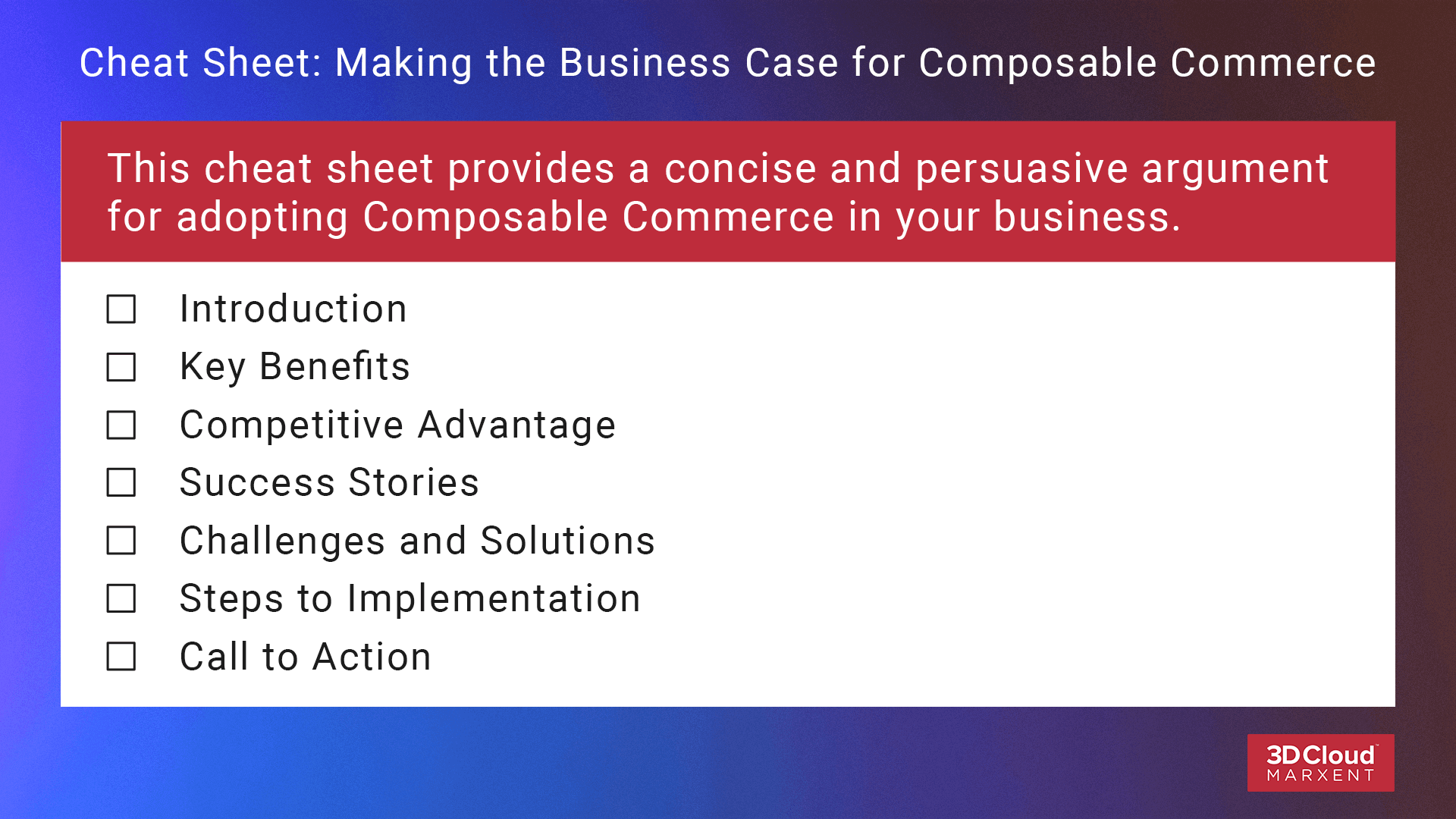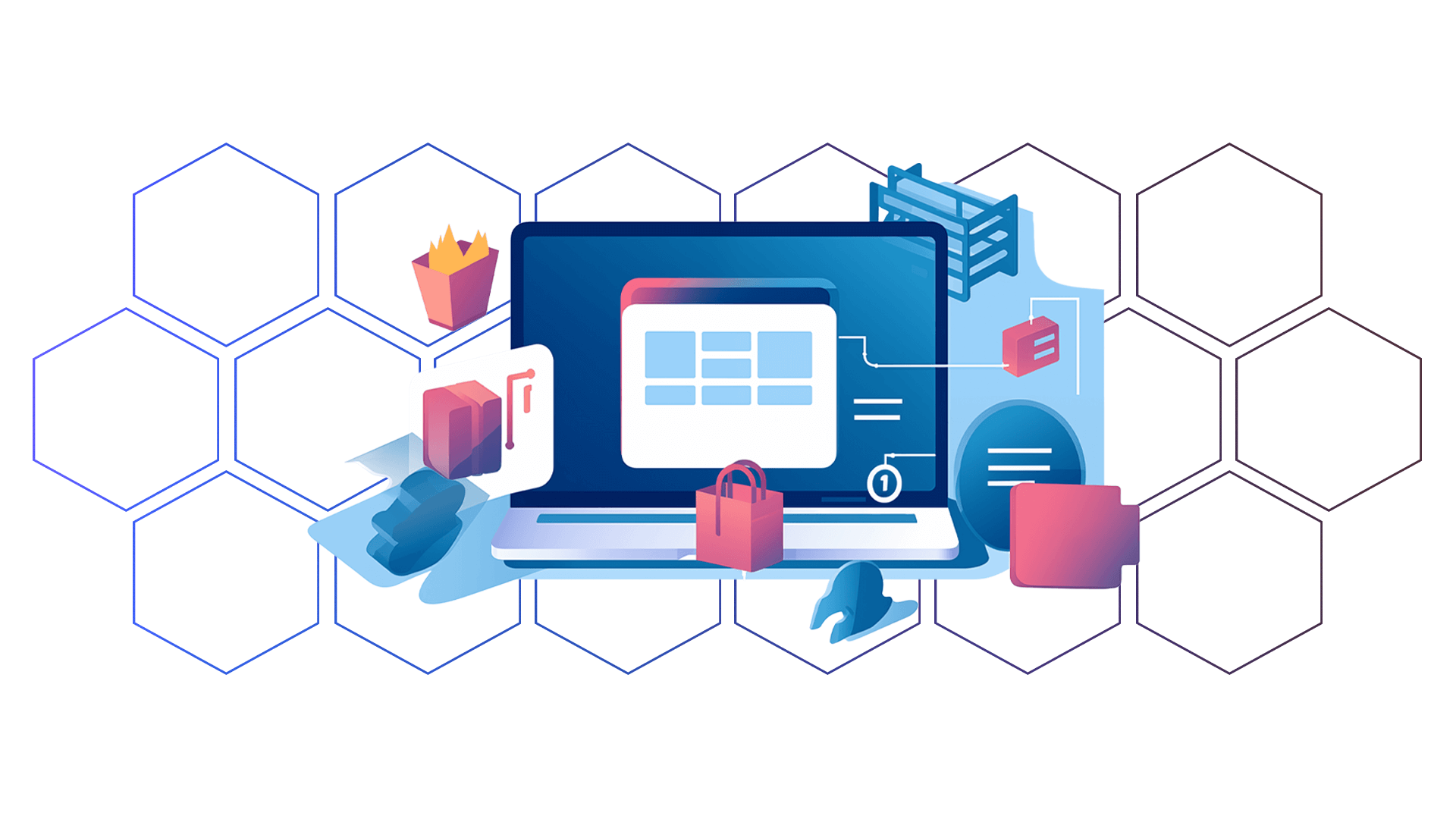
Composable commerce enables online sellers to be ready for anything. This guide explores the tech and mindset behind it and prepares you to move fast in the rapidly evolving world of e-commerce. Read expert advice and see if composable commerce is the right choice for your business.
Inside this article:
What is composable commerce?
Composable commerce is a way of building flexible online shopping experiences by combining separate software components to meet specific needs. It empowers businesses to create personalized e-commerce solutions that quickly adapt to consumer and user demands. Composable commerce uses APIs and other tech to combine components seamlessly.
The term “composable commerce” combines “compose” (creating something from many parts) and “commerce” (the process behind selling products). Gartner, an IT research firm and consulting company, coined the term in a 2020 research paper titled “Composable Commerce Must Be Adopted for the Future of Applications.” As the name suggests, composable commerce describes the practice of “composing” an e-commerce experience from multiple applications or modules.
These modules are the fundamental building blocks of an e-commerce site or app. Under modular commerce, each module has a specific role related to the e-commerce experience. Some examples include modules that handle the shopping cart, payment processing, inventory management, customer recommendations, and personalization. Composable commerce enables businesses to choose and blend these modules, effectively “composing” a tailored e-commerce experience. This flexibility allows businesses to modify components without affecting the entire e-commerce system.
Many experts use a Lego analogy to describe this concept. Imagine building a digital platform, like a website or software, with Lego blocks. Each block represents a module with a well-defined function. Like building with Legos, you can mix and match modules to create a fully functional and personalized e-commerce ecosystem. This results in a website perfectly suited to the specific requirements of the business.
Composable commerce approach
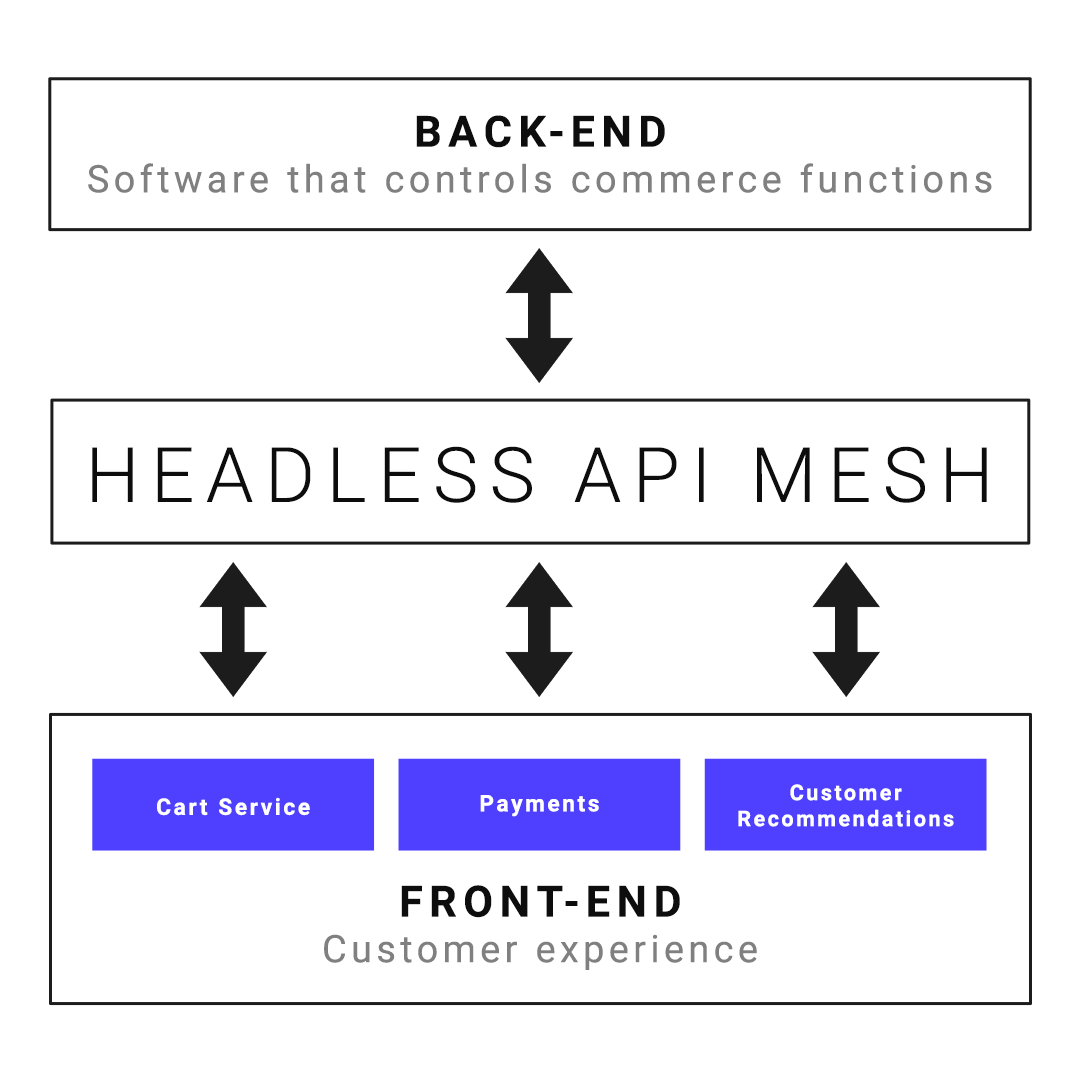

Mark Catalano, founder of TakeShape, which provides front-end data orchestration for composable commerce
Mark Catalano, co-founder and CEO of TakeShape, a company specializing in front-end data orchestration for composable commerce, says that the Lego “plug and play” vision is still far from reality.
“We can’t just swap out different modules like Lego bricks,” Catalano says.
“When people talk about composability, what they mean is composing an e-experience together—taking ideas and tools from lots of different places. This approach contrasts the legacy approaches, where big monolithic website architecture drove all the functionality.”
Nick Prebezac, founder of Nimbus Interactive, describes composable commerce this way:

Nick Prebezac, developer and designer
“One of the primary goals of composable commerce is to overcome the limitations of previous technology and leverage modern capabilities while maintaining the flexibility to adapt to future changes. By selecting the best components, businesses can tailor their e-commerce platforms to match current needs and easily replace or update individual parts without disrupting the entire system.”
Prebezac describes composable commerce as “the new frontier in e-commerce.” But, as with any new system, composable commerce has challenges alongside its opportunities.
“While composable commerce poses its share of complexities, understanding and mastering it is imperative for any business aiming to thrive in the evolving market,” Prebezac says. “It’s not just a trend; it’s a strategic move that levels up businesses.”
Businesses definitely have taken note of composable commerce. In a 2020 Wunderman Thompson survey of 400 e-commerce experts and business leaders in the U.S. and the U.K., only 2% didn’t plan to adopt new composable technologies. In its report, “Composable and Connected: The Future of Commerce Platforms,” Wunderman Thompson underscores that composable commerce isn’t just the future of e-commerce; it’s already here. To stay competitive, many modern online businesses will need to transition to composable architecture.
Key Takeaways:
- Composable commerce enables businesses to mix and match e-commerce solutions to meet their unique needs.
- Composable architecture is the best way for businesses to meet growing customer expectations for exceptional e-commerce experiences.
- Composable commerce helps businesses scale quickly, improve website performance, and adapt quickly to changing demands.
- To transition to a composable architecture, try a hybrid approach and change your e-commerce strategy one piece at a time.
- Composable commerce is best for mature organizations with strong in-house teams ready to maximize the potential of composable architecture.
Why is composable commerce in demand?
Composable commerce is in demand because it allows businesses to respond quickly to growing customer demands. It helps companies to remain agile in a constantly changing e-commerce landscape.
“There are two major pressures moving composable commerce forward,” says Catalano. “First, web developers are interested in building this type of architecture. Second, business demands are influenced by the rapidly changing commerce landscape, which, in turn, is shaped by customer preferences. To stay competitive, businesses must be able to adapt their e-commerce strategy quickly.”
Today, consumers engage with businesses across many digital platforms, from websites and mobile apps to IoT devices such as smartwatches and appliances. Customers expect more and more from their online shopping. They demand personalized shopping experiences, quick websites, easy returns, hassle-free shipping, 3D visuals, and more. To be successful, e-commerce businesses must rapidly respond to shifting customer needs while outpacing competitors.
Composable commerce has emerged as the solution to meet these demands, enabling businesses to change their software and websites, all without any noticeable hiccups in website performance.
Catalano emphasizes: “I was working on this over a decade ago; there’s nothing fundamentally new about it. It’s a reconfiguration of architectural concepts that have been around for quite some time. Improved tools, tech, and a better business case for the system are driving renewed demand.”
The 4 tenets of composable commerce
The first three tenets of composable commerce are modular architecture, open systems, and flexible design. The fourth is business-oriented design, which allows owners to choose among multiple vendors to meet their needs.
Here are the details of the four tenets of composable commerce:
- Modular architecture: In composable commerce, the e-commerce system comprises separate modules or components that can operate independently. Each module focuses on a specific task, like managing products, processing payments, or fulfilling orders. The developer can update, replace, or scale these modules individually without affecting the entire system. This modularity allows a business to mix and match these modules to create a customized e-commerce system that specifically addresses their needs.
“Composable commerce’s modular architecture fundamentally transforms how businesses approach system maintenance,” developer Prebezac says. “By isolating components, it minimizes the potential ripple effects of updates or replacements, ensuring that businesses can swiftly address issues or bugs. This not only streamlines maintenance efforts but also significantly reduces the complexity of managing a large e-commerce ecosystem. The result is a more agile and responsive business infrastructure that can adapt to evolving market demands with ease.”
- Open or autonomous ecosystem: Open ecosystems support integrations across different apps, technologies, and platforms. In contrast, a closed system can only integrate with platform-specific tools.
Composable commerce uses open environments with APIs (application programming interfaces) to integrate various modules into the system. This feature allows businesses to select among different vendors and solutions.
Gartner and other organizations describe this concept as “orchestration” because businesses can orchestrate the modules to achieve specific outcomes.
- Flexibility: Composable commerce empowers businesses to adapt their system quickly. The modular architecture and open ecosystem provide the foundation for this flexibility. Companies can easily explore offerings from different vendors and modify their systems to improve the customer experience at any stage.
- Business-centric: The term “business-centric” in composable commerce refers to tailoring e-commerce solutions to meet the specific needs of individual businesses rather than adhering to a rigid, one-size-fits-all model. This approach empowers businesses to have greater control over their e-commerce ecosystem and quickly change along with evolving market conditions, customer expectations, and technological advancements.
Moreover, being “business-centric” is closely linked to the concept of “Packaged Business Capabilities” (PBCs) within the composable commerce framework. A PBC is a specialized module that provides a specific business capability or functionality. It is a pre-packaged, ready-to-use component that serves a distinct purpose, such as product recommendation, payment processing, or inventory management. Developers can easily integrate PBCs into the composable commerce ecosystem and offer specialized services from third-party vendors.
Composable commerce vs. legacy approaches
Composable commerce and legacy approaches differ fundamentally in their approach. Composable commerce uses a headless architecture that is easy to customize. Legacy approaches use monolithic architecture with less flexibility.
Catalano, CEO of TakeShape, likes composable commerce to design a custom-built home.
“Do you want to live in a pre-designed or fully customized home? The first option is much less expensive and doesn’t require you to make many decisions,” he says. “But it’s a cookie-cutter design—you get what you get—and you can’t craft the experience that works well for you.”
Here is a brief overview of the major differences between composable commerce solutions and legacy approaches. Other differences will become evident as we dive deeper into the tech and the benefits of composable commerce throughout the article.
- Architecture and flexibility:
- Composable commerce: Uses a modular architecture, combining various modules. You can replace or update each module individually without impacting the entire website. This modularity allows businesses to react rapidly to any disruption or change.
- Legacy approaches: Follows a monolithic architecture housed within a single application like a CMS (for example, WordPress). Changes to one aspect affect the entire system. So, when you want to improve one part of your website, you need to take the time to test how that change will affect the entire system.
- Headless systems, agility, and scalability:
- Composable commerce: Employs a headless content management system that separates the front end (what the customer sees and interacts with) and back end (commerce functions). The front end ensures a visually appealing and intuitive user experience, while the back end handles business functions like order processing. In a headless system, this decoupling allows agility and scalability without disrupting the other, enhancing overall performance.“There actually isn’t much of a difference between composable commerce and headless solutions,” says Catalano. “The term ‘composable’ started to become more popular because ‘headless’ was confusing to business owners. Composable solved some marketing needs because it was easier to understand. But, in terms of functionality, there’s not much difference. They both focus on separating the front-end stack from the back-end APIs that provide the data and functionality.”
- Legacy approaches: Use “headful” systems with interconnected front-end and back-end, leading to slower time-to-market and increased complexity.
- Vendor lock-in and innovation:
- Composable commerce: Allows businesses to choose vendors for individual modules. Catalano says that one of the prime advantages of composable commerce is the freedom to mix and match vendors to find the best solutions for specific needs.
“Today’s customer demands are ever-evolving, and no single solution can meet all their needs,” Catalano says. “These demands will only continue to grow. Take reviews, for example. Customers initially wanted user-generated reviews, but their expectations expanded to include images, reviews with photos, videos, and more. No single vendor can keep up; there’s no one-size-fits-all e-commerce solution. A significant benefit of composable commerce is its flexibility to choose vendors that best suit each specific service and switch vendors when necessary.”
- Legacy approaches: Lock businesses into a single ecosystem so they can only shop for vendors that make platform-specific tools.
Examples of composable architecture
Examples of businesses that use composable architecture include Lego, Puma, and Sainsbury’s. They use it to improve the customer experience. It also helps them handle more website traffic, improve speed, and process more orders.
For many companies, composable commerce has become the de facto way to do business.
Here are some real examples of composable architecture in today’s e-commerce market:
- Lego uses headless e-commerce to handle more orders: Lego needed help to fill orders on time and meet surging website traffic. To solve this problem, they adopted a MACH approach. MACH stands for Microservices, API-first, Cloud-native, and Headless.
In an interview with the website diginomica.com, Simon Young, the senior engineering director of Unified Commerce Group, summarizes Lego’s problem this way: “We had this inevitable challenge of you can’t react very quickly, and when you do react, you can’t react fast enough.”
To fix the problem, Young says, “We wanted something that was completely headless, that was API-first so that we could Lego could improve the customer experience rather than needing to be guided by the way that the company and the commerce platform thought it should be implemented. If you’ve got the APIs, you can decide what the user experience looks like.”
In the same interview, Young describes how they used a hybrid approach of “strangling the old platform piece by piece.”
The article describes Lego’s change: “The move has been a huge success, which is evident from the site’s performance.” Lego introduced 100 new products on January 1, 2020, and can log 2,000 orders per minute—a conversion that would have immediately crashed their old website, which ran on monolithic architecture. A year after Lego adopted a more composable strategy, it experienced a 46% growth in year-over-year revenue.
- Sainsbury’s responds to a surge in online ordering: During the pandemic, online orders doubled for U.K. grocery store chain Sainsbury’s within six months. To manage the demand, they needed to transform their e-commerce capacity. They worked with Wunderman Thomson to integrate aspects of composable development and create a “multi-channel platform capable of supporting 20K-30K orders a day.” The new system supports $1.5 billion in online sales and handles more than 12 million orders a year.
- Puma uses headless architecture for faster updates: The sportswear company Puma has adopted cloud-first, headless, API-first aspects into its digital stores. Dylan Valade, Puma’s head of global e-commerce technology, says the company uses composable commerce approaches to make smoother updates to the site. In an interview with the MACH Alliance, Valade says that he transitioned Puma to centrally managed cloud services because the monolithic architecture took months to integrate new updates.
- Composable commerce helps a B2B company go B2C: Catalano, the founder of TakeShape, works with a large, multi-national consumable car parts brand. This company usually engages in B2B (business-to-business) transactions by selling car parts to auto manufacturers and mechanics. To begin their B2C (business-to-consumer) sales, they turned to TakeShape to build a composable, API-first experience to drive their e-commerce platform.
“For this customer, we seamlessly integrate data from legacy APIs, product information systems, and Shopify, enabling us to achieve composability at the API level,” Catalano says. “This approach allows us to create a unified API that seamlessly handles car part fitment across diverse part taxonomies, delivering a superior customer experience that a monolithic architecture wouldn’t be able to handle. With TakeShape acting as middleware, we can compose data and functionality together across services.”
Core technology of composable commerce
The core technology of composable commerce includes JAMstack and MACH. JAMstack stands for JavaScript, APIs, and markup. MACH stands for microservices, API-first, cloud-native, and headless. Web developers use both to build composable architecture.
JAMstack and MACH represent different modern development approaches that support composable commerce principles. Developers use these concepts in diverse ways to build composable architecture.
MACH architecture focuses on defining principles that help businesses decide which vendors to use. On the other hand, JAMstack is a way to create fast, headless websites that align with key composable commerce features.
Here’s a more detailed look at JAMstack and MACH:
- JAMstack: JAMstack empowers developers to build scalable and high-performance websites by using JavaScript, APIs, and markup to create a decoupled and modular architecture.JAMstack is different from usual platforms like WordPress used for making websites. Unlike WordPress, which uses one server, JAMstack lets a developer use different tools to create websites and apps. This way, JAMstack keeps the website’s look and feel separate from the moving parts that make it work. This helps the website to open and respond fast, giving visitors a better user experience. Here’s how JAMstack works:
- JavaScript: In a headless commerce setup, developers use JavaScript to build the application’s front end. It helps developers include interactive elements on the website to improve the user experience and enable real-time updates without page reloads. It communicates with the back end through APIs. This separation means that the website’s visuals are separate from the dynamic functionality, which helps a website load and run faster.
- Markup: Markup (usually HTML) defines the static structure and page layout, including headings, paragraphs, images, and more. It provides the foundation for content presentation and organization.
- APIs (Application Programming Interface): APIs define the methods and data formats that software can use to request and exchange information between one another. They serve as the glue that links the front-end (that developers build with JavaScript) and back-end services. They enable the user interface and core software to exchange data, ensuring that web and mobile apps work seamlessly.
- MACH: The MACH Alliance is a not-for-profit organization that advocates for best-of-breed enterprise technology systems. They developed the “MACH” concept to summarize the key application development principles that offer a truly composable experience. Unlike JAM, MACH doesn’t dictate a developer’s technologies. Instead, it outlines the developer’s end goals. That means developers can use MACH principles to develop channels outside of websites and apps, like enterprise software.
MACH stands for microservices, API-first, cloud-native, and headless. Businesses can effectively implement a composable solution by choosing products that adhere to these principles. A product or service can register with the MACH Alliance and become “MACH-certified” if they follow a purely MACH approach.
Here’s more about the specifics of MACH:
- Microservices: Microservices are the specific, independent building blocks in a composable commerce ecosystem. Each microservice handles a specific business function or capability. Businesses can deploy and scale microservices independently from one another to change one aspect of a website without affecting the entire page.
“Microservices are very closely linked with the concept of PBCs and modules,” explains Catalano. “Many people use the terms interchangeably, which isn’t always correct, but the overlapping terminology doesn’t generally cause issues in implementing composable solutions. One way to think about it is that microservices are the specific business capabilities, PBCs are specialized microservices, and modules are the general building blocks in the composable commerce architecture.”
- API-first: The API-first approach relates to software development. API-first digital commerce platforms design APIs allowing a specific software to integrate with other software or programs. API-first also describes a mindset that prioritizes the value an API can deliver to a business.
Prebezac notes the benefits of an API-first system: “Easy integration through APIs and microservices architecture enables seamless connectivity with other systems like inventory, shipping, payment, and CRM. This integration flexibility enhances operational efficiency and provides businesses with a comprehensive ecosystem to meet evolving customer needs.”
Catalano stresses the importance of making composability work at the API level, ensuring that various parts of a website can communicate smoothly.
“A common way to build a website is by putting together various JavaScript widgets, but this often makes the website slower over time,” he says. “An alternative approach is to create what we call an ‘API mesh-layer.’ Here, a user can make a single request, and the API mesh takes care of making the website run smoothly. It manages how the website performs, combines the necessary data, stores it for quick access, and organizes it effectively. This way, when you need to ask for different things on the website, it’s much faster and more efficient.”
- Cloud-native: Cloud-native software is delivered via the SaaS (“software as a service”) model, where a cloud provider hosts applications. Users can access the application from the cloud via the internet. Software that you put into the cloud after development is not cloud-native. Cloud-native infrastructure allows businesses to scale their e-commerce services based on demand without physical servers. This elasticity supports a composable architecture because individual modules scale to handle rising traffic.
- Headless: The headless approach in MACH involves decoupling the front end (user interface) from the back end (commerce engine and services), and it is a defining feature of composable solutions.
When you separate the front and back end, businesses can easily switch, update, or customize the front-end experience without affecting the underlying e-commerce functionalities. This decoupling fosters a modular and composable system that enables businesses to compose and rearrange front-end components to craft personalized customer experiences.
Why is composable commerce important?
Composable commerce is important because it’s one of the best ways to meet customer demands. It also allows businesses to adapt and scale quickly without compromising website performance.
Modern consumers now consider innovative and exceptional shopping experiences as the norm. Lightning-fast loading times, hassle-free returns, rapid shipping, and immersive 3D integration represent the new e-commerce baseline.
Here are more detailed reasons why composable commerce is important:
- Helps businesses meet consumer expectations
Today’s consumers demand amazing experiences. They expect businesses to be present on multiple channels, offer innovative features, and provide outstanding customer experiences. Achieving these ambitious standards is realistic with a composable commerce solution. - Helps businesses adapt to rapidly changing demand
The COVID-19 pandemic ushered in unpredictable changes in customer demand. To adapt to unexpected twists, businesses need auto-scaling capabilities that don’t compromise the customer experience.
“A well-architected composable system simplifies change and reduces risks,” Catalano says. “It’s a valuable investment for any business aiming to build resilience in the face of inevitable and unpredictable change.”
- Necessary to stay competitive
In today’s fast-paced business landscape, maintaining competitiveness goes beyond just meeting customer expectations—it’s about exceeding them. Those organizations that can deliver smooth, personalized, and extraordinary customer experiences thrive in the modern market.
How is composable commerce changing e-commerce?
Composable commerce is changing e-commerce by helping businesses quickly adapt to customer needs and create customized websites. It also lets them combine the best vendor tools to create a better online shopping experience.
Here’s how composable commerce is changing e-commerce:
- Help businesses rapidly adapt and respond to market demands:
Composable commerce allows businesses to swiftly adjust their strategies and offerings based on changing customer needs and market trends. This adaptability ensures they remain agile and competitive in the ever-evolving e-commerce landscape. For example, if customers start showing a preference for a specific payment method, businesses using composable commerce can quickly integrate it. - Customized experiences:
With composable commerce, businesses can create highly customized e-commerce websites that cater to their target audience’s unique requirements and preferences. This level of personalization allows for tailored product recommendations, individualized marketing messages, and a user interface that aligns perfectly with the brand’s identity. - Best-of-breed solutions from multiple vendors:
Composable commerce empowers businesses to seamlessly integrate a wide range of tools and services from different vendors. This means they can combine specialized solutions for payment processing, shipping, customer reviews, and more in one cohesive platform. As a result, the shopping experience becomes more versatile and user-friendly, with multiple features smoothly working together. - Improved website performance:
Composable commerce places a significant emphasis on website performance. In response to consumer demands for lightning-fast load times and seamless interactions, businesses use this approach to optimize their websites for speed and reliability. This ensures that users have an easy, frustration-free shopping experience, which is crucial for customer satisfaction and retention. - Enhanced customer experience
Ultimately, composable commerce delivers a more personalized and customer-centric shopping experience. Businesses can utilize data and customer insights to tailor their offerings, suggest relevant products, and create a more intuitive purchasing process. The result is a shopping experience that feels unique and engaging, which is likely to foster loyalty and repeat business. - Improved 3D Integration:
It’s easier to support 3D files in a composable architecture than a monolithic one. 3D visuals allow businesses to enhance product visualization and create immersive shopping experiences. This means customers can interact with products in three dimensions, gaining a better understanding of their features and qualities. For industries like fashion, home decor, or automotive, 3D assets can be a game-changer.
Benefits of composable commerce
The major benefit of composable commerce is that businesses can create customized websites that best suit their customers. Also, you can quickly add, modify, or remove applications without affecting the rest of your website.
Here’s a summary of the major benefits of composable commerce:
- Helps “future-proof” your business:
Composable commerce promotes innovation by allowing businesses to experiment with new components and technologies easily. The modular nature enables businesses to adopt new features and tools quickly and helps them stay ahead in a competitive market. According to Gartner, businesses that adopt composable commerce “will outpace the competition by 80% in speed of new feature implementation.”
- Flexibility:
Composable commerce enables businesses to build and customize their e-commerce systems by composing and integrating best-of-breed components. It allows companies to remain agile and adaptable because they can quickly add or remove components based on changing needs.
Prebezac describes the flexibility of composable commerce this way: “The headless approach in composable commerce is like having a detachable car interior. You can customize your ride without meddling with the engine. Decoupling the front-end from the back end lets businesses swap out, upgrade, or personalize user experiences while maintaining the integrity of their e-commerce functionalities.”
- Vendor independence
Composable commerce reduces vendor lock-in by providing the flexibility to choose and replace individual components. Organizations can select the best solutions for each aspect of their e-commerce ecosystem, fostering competition among vendors and avoiding reliance on a single provider. - Scalability:
With a modular architecture, composable commerce allows for scaling specific components independently. This flexibility ensures that businesses can handle increased traffic, transactions, and data volumes without requiring a complete overhaul of the entire system.
“A core pillar of composable commerce is that key functions can auto-scale automatically,” Catalano explains. “That means that a website can support unpredictable demands without lagging or otherwise compromising the customer experience.”
- Simplified maintenance:
By decoupling components, composable commerce simplifies system maintenance. Developers can update, patch or replace parts without affecting the entire system. It reduces the risk of disruptions and makes it easier to address issues or bugs. - Easy integration
Composable commerce leverages APIs and microservices architecture, making it easier to integrate with external systems such as payment gateways, shipping providers, inventory management, CRM, or marketing automation tools. - Potentially increases revenue
Composable commerce has the potential to significantly increase revenue for businesses in various ways. It empowers companies to swiftly adapt and customize their e-commerce infrastructure, ensuring they remain competitive by responding to changing market trends and customer preferences. According to McKinsey, businesses that prioritize customer experience see a 15 to 20 percent increase in revenue.
Composable commerce also fosters innovation by enabling the rapid deployment of new features and technologies that can attract a broader customer base and set the business apart from competitors. The flexibility to experiment with new business models and expand into emerging markets opens new revenue streams.
- Gives businesses the ability to pivot
The building blocks of composable commerce allow businesses to respond to change and make large changes quickly and successfully. For example, Garter describes a Chinese appliance manufacturer that pivoted from making dishwashers and wine coolers to distributing critical medical equipment during the COVID-19 pandemic. Their composable architecture allowed them to reposition the building blocks of their e-commerce setup and respond immediately to a sudden change in consumer demand.
Challenges of composable commerce
The main challenges of composable commerce stem from its inherent complexity. It’s not cost-effective for small organizations that may be unable to handle the transition. Also, it’s challenging to manage a network of vendors, APIs, and other components.
“Composable commerce is definitely not for everyone,” says Catalano. “Monoliths still have their place and can be more cost-effective for smaller businesses with simpler needs. However, as a company matures in terms of customer experience requirements, composable commerce starts to become a compelling option.”
While there’s a strong business case for most organizations to embrace composable commerce, the transition is usually difficult. It’s also important to note that not every organization must adopt a composable architecture to be successful.
Here’s a list of some of the challenges associated with composable commerce:
- Requires a large up-front investment
Composable commerce often necessitates a substantial up-front investment. The initial costs arise from integrating multiple components, managing API connections, evaluating and selecting vendors, and more. - Requires strong internal skillset
“As soon as you start thinking about composable commerce, you’ll need to write a custom backend,” says Catalano. “You’ll also need to start thinking about an API layer or gateway—that’s where this kind of solution really starts.”Businesses need skilled developers and IT personnel who can work with APIs, maintain integrations, and ensure the overall health of the composable commerce system. You’ll need to have strong in-house development capabilities with a solid network of developers and a strong CTO (chief technology officer). - Security concerns
Security risks increase with multiple components and third-party integrations. Safeguarding the entire system and ensuring compliance can be complex. - Vendor selection and management
Businesses need to carefully select and evaluate the various vendors and components they wish to integrate. This requires in-depth research and due diligence to choose the right partners and tools. - Expensive to manage
Composable commerce involves integrating multiple components and managing API connections across various services. As a result, composable commerce often results in higher ongoing maintenance and support costs. Businesses may also need dedicated development teams or external experts to handle continuous updates, enhancements, and maintenance. In contrast, legacy approaches under a monolithic architecture require much less time, effort, and resources in both the setup and ongoing management of the commerce stack. - Consistency and user experience
Maintaining a consistent and seamless user experience across various components and services can be a challenge.
Composable commerce pros and cons
Evolution of Composable Commerce
Composable commerce evolved from the first online retail websites in the late 1990s and early 2000s. As technology and social habits changed, developers created composable and headless solutions to meet customer demands.
The evolution of composable commerce
Future of composable commerce
The future of composable commerce will reshape how businesses engage with customers online. Personalization will reach new heights, and online and offline experiences will continue to intersect. Composable commerce will also become even more modular.
Product configuration used to be complex and required extensive training. Now, according to Beck Besecker, CEO and Co-Founder of 3D Cloud by Marxent, things are changing. “Customers, even at the enterprise level, are seeking self-service options for more control. They want to visually create or co-create configurations during the sales process,” Besecker said.
“Composable commerce has had a huge impact on the customer experience through improved personalization, adaptability, and scalability for specialized e-commerce features,” he said. ”This new generation of composable product configuration solutions simplifies providing interactive, self-service options to both sales associates and consumers, enhancing the overall customer journey.”
Here are several key trends and developments that experts think will shape composable commerce:
- Advanced integration
The establishment of industry-wide integration standards and protocols will play a pivotal role. These standards will improve the interoperability between different modules, ensuring that businesses can easily “plug and play” with various services. Standardization will reduce development effort and accelerate the adoption of composable commerce.
“We want everyone to be able to adopt composable architecture,” Catalano says. “My goal is to democratize this type of tech in the same way that Shopify democratized the idea of having an online store. Right now, everyone working in composable is still on the cutting edge, and these concepts haven’t been widely adopted. But composable, microservices, MACH—they’re are improving and moving us toward better and easier ways of decoupling the front and back end.” - Growing API ecosystem
A robust and ever-expanding API ecosystem will be essential for composable commerce. As more third-party services and components become available, businesses will need well-documented and reliable APIs to integrate them effortlessly. API management and governance will be critical for maintaining a coherent and secure architecture. - Improved vendor ecosystem
A thriving vendor ecosystem will be a driving force. As more solution providers enter the market, businesses will have a broader selection of components to choose from. Competition in this space will encourage innovation and improve the quality of available components. - Advanced personalization.
Personalization will reach new heights, with businesses leveraging vast amounts of customer data and AI-driven insights to tailor shopping experiences at a granular level. Composable commerce will allow for the integration of personalization tools, enabling businesses to provide individualized product recommendations, pricing, and content delivery, ultimately enhancing customer satisfaction, and driving higher conversion rates. - Omnichannel and unified experiences
The lines between online and offline commerce will continue to blur. Composable commerce will play a pivotal role in creating unified shopping experiences across various touchpoints, whether in-store, on a website, through mobile apps, or on social media platforms. This omnichannel approach will enable customers to transition seamlessly between channels and devices, fostering greater convenience and engagement. - Sustainability initiatives
As businesses prioritize sustainability, composable commerce will evolve to support eco-friendly components and practices. Integration with green supply chain partners and the ability to measure and report on environmental impact will become critical. - Virtual (VR) and augmented reality (AR)
Composable commerce architecture will enable the integration of VR and AR technology so customers can interact with products immersively. Virtual showrooms, for example, will provide customers with the opportunity to visualize how furniture, clothing, or other items will look. Businesses will be able to integrate AR try-on features for apparel or cosmetics, enhancing customer confidence and reducing return rates. This technology will be critical as metaverse e-commerce grows and eventually dominates the market.
Is composable architecture right for your project?
Composable architecture can be a good fit for complex projects where you want to create an exceptional customer experience. To determine if it’s the right approach, assess your in-house expertise, resources, and long-term vision.
Composable architecture has many advantages, but it’s not always the most effective choice.
“As you start to ramp up in the maturity of your customer experience, composable commerce is a no-brainer,” says Catalano. “But you must realize that as soon as you start thinking about that, you need to also think about how you’re going to manage the various complexities that come with a composable architecture. It’s an organizational step-up that not all businesses can or need to handle.”
Here are a few ways to assess whether composable commerce makes sense for your project.
- Assess organizational maturity
Before deciding on composable commerce, evaluate your organization’s maturity level. If you’re a smaller or less experienced company, platforms like Shopify may be a more cost-effective solution. Composable commerce often becomes more appealing as your organization matures and requires a more sophisticated approach to customer experience. You’ll also need to have an in-house staff of developers knowledgeable about composable architecture, even if you plan to outsource it.
- Project timeline
Assess your project’s timeline and deadline constraints. While composable architecture offers long-term benefits, it may initially require more time for careful planning and integration. - Project scope and complexity
The complexity of your project is a crucial factor in considering composable commerce. If your project involves intricate customer experience requirements and demands a high degree of customization, composable commerce is the best choice. - Customization needs
Evaluate the level of customization your project demands. Composable commerce will help you create highly customer-specific experiences tailored to the preferences of each individual. - Long-term vision
Your long-term vision for the project plays a pivotal role in deciding if composable commerce is the right fit. If you think your project will grow, composable architecture can adapt and align with your future goals. - Resource availability
If this is your first plunge into composable commerce, you will likely need to invest money and time into building a skilled team, identifying third-party vendors, and setting up the appropriate infrastructure and technology. Ask yourself if your business has the necessary resources.
Could a hybrid approach make sense for your project?
A hybrid approach that combines composable and legacy approaches makes sense for many projects. It can be the final solution or an interim step before a fully composable solution. It minimizes risks and has the benefits of composable architecture without a substantial upfront investment.
Composable commerce and legacy approaches can operate side-by-side. This hybrid approach allows a large business to build a composable architecture while running its current e-commerce setup. This minimizes the risk associated with the transition.
Here’s Prebezac’s advice: “To determine if a hybrid approach makes sense for your project, consider the benefits and challenges of the ‘best of both worlds’ scenario. Composable architecture isn’t a one-and-done replacement; it’s a creative solution. It allows companies to experiment and ‘fail fast’ while coexisting with legacy systems, minimizing risks and enabling a smooth transition.”
Cheat Sheet: Make the Case for Composable Commerce
Download our Composable Commerce Cheat Sheet and supercharge your pitch for why your business needs composable commerce to thrive.
First steps toward your own composable commerce solution
To develop your composable commerce solution, focus on enhancing elements that offer high customer value. Begin by establishing an API gateway, and don’t focus on completely decoupling your website. Seek an experienced tech partner to help you transition.
Many businesses find themselves at a loss when developing a composable commerce solution, especially if they already have an existing e-commerce website. Transitioning can be a challenge, but it’s essential to preserve your e-commerce site’s functionality and user experience while evolving.
Here’s how to start your journey toward composable commerce:
1. Start with APIs
“Composability is most crucial at the API level,” emphasizes Catalano. “Begin by establishing an API gateway or an API mesh layer. Through an API gateway or mesh layer, you lay the foundation for the decoupling of various system components. This means that individual modules, services, or microservices can operate independently and evolve without being tightly intertwined with others. They gain the flexibility to adapt and scale autonomously. But the APIs allow the different parts to communicate and collaborate with one another.”
2. Change one domain or service at a time
“Going composable” doesn’t need to be an all-or-nothing experience. You can use your API gateway to alter everything one by one.
Many experts suggest choosing a single domain or business area to decouple. Start by showing this specific section of the site to a selected audience, such as guest customers. Employ A/B testing and iterative development to make gradual improvements. This “hybrid” approach lets you keep your e-commerce site up while you’re making small improvements.“
Avoid the temptation to rush both front-end and back-end changes simultaneously,” advises Prebezac. “Organize your composable transformation one step at a time. This methodical approach simplifies resource allocation, technology integration, and budget management, ultimately aligning outcomes and timelines for success.”
3. Focus on high-customer value first
Begin by looking at your domain from the perspective of your customers. Identify the features or components that would most significantly enhance their experience. Focus on addressing high-priority items first, and gradually work through your list. For instance, refining customer-centric items like the search function or shopping cart would be strategic places to start.
4. Don’t blindly imitate another business’ solution
It might be tempting to seek inspiration by emulating how other businesses are implementing their composable solutions. However, this approach contradicts the fundamental concept of a composable and customizable experience. The beauty of composable tools lies in their capacity to tailor components to your unique business requirements, aligning with your distinct values and goals.
In other words, composable commerce aims to break from the one-size-fits-all mold. While drawing inspiration from others is valuable, it’s crucial to ensure that any adaptations align with your long-term vision and serve the specific needs and objectives of your business.
5. Work with a tech delivery partner
In a survey of 400 people who occupy senior e-commerce positions across the U.K. and the U.S., 86% said they wanted to work with an experienced tech delivery partner to move toward a modern architecture. This statistic underscores that many businesses may lack the in-house expertise to confidently build a composable architecture.
Fortunately, the landscape is evolving, with a growing number of intermediary organizations creating “middleware” to facilitate the move from legacy systems to composable approaches. Partnering with a tech delivery partner with pre-built SaaS solutions is an effective way to take an incremental step toward the target architecture.
6. Scrutinize your vendors.
Carefully assess your vendor relationships and ensure they align with your composable strategy and long-term business goals. Vendors play a critical role in providing the components and services that enable your composable ecosystem. Choose partners who support your long-term vision and growth.
Create immersive composable commerce with 3D Cloud by Marxent
The future of online shopping will be heavily reliant on 3D visualization and configuration. 3D Cloud by Marxent is the top 3D solution provider, with a 3D CMS and applications that easily integrate with a composable commerce strategy.
3D Cloud is a composable commerce building block that empowers your business to stay ahead in the future of online shopping. By seamlessly integrating 3D Cloud solutions into a composable commerce strategy, 3D commerce retailers and manufacturers can enhance the customer experience and stay competitive.
3D Cloud by Marxent offers an efficient approach to vendor consolidation across all 3D applications, including 3D asset management, WebAR APIs, code-free 3D product configurators, and 3D room planner applications. The 3D Cloud CMS provides a single source of truth for 3D products that can be utilized across applications and downloaded into consumable format types for various platforms. The product suite supports billions of configurations, and the company is known for industry-leading visual realism. Businesses ready to lead the way in 3D e-commerce partner with 3D Cloud by Marxent.

